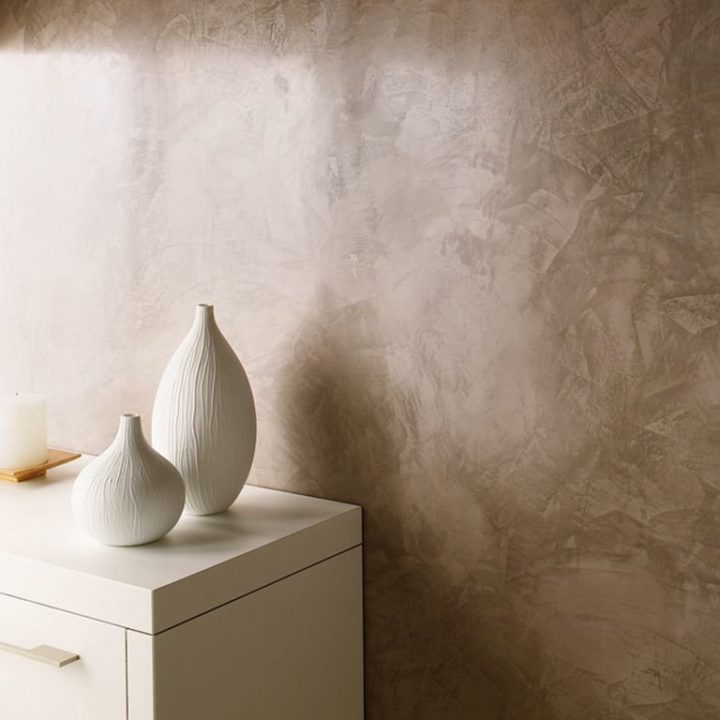
Stucco
Lime mortar for polished stucco finish, fresco work and fresco painting
EcoMortar® Stucco is a pre-mixed pure lime mortar developed to obtain a polished surface. It consists of natural lime, fine granulometry aggregates including talc and additives to help the applicator avoid shrinkage and tearing. It does not contain cement or other pozzolanic components.
Packaging
10 kg tub
Shelf life and guarantee
6-8 months from production date if protected in the original packaging and stored in dry conditions. Once mixed with water the mortar will be usable for up to 1 week. Manufacturer Civil Responsibility.
Mixing
1 kg of EcoMortar® Stucco + 600/800 grams water. Use a powerful whisk for about 5 minutes adding water gradually. Longer if mixed manually. If possible, leave the mixed mortar for a few hours or until the day after to achieve an even greater workability.
Consumption
About 1.5 kg per mm of thickness per m2.
Background preparation
The application background has to be prepared to offer a smooth surface without protruding coarse aggregate grains that might cause tearing when the EcoMortar® Stucco is floated. To prepare the background use Saint-Astier® NHL lime mortars with a fine aggregate (0 to 0.8mm) top coat, floated with a wooden float. On plasterboards or backgrounds with no suction apply a first coat of EcoMortar® BasePlaster* (about 3mm). The EcoMortar® Stucco work can start on this surface about 2-4 hours later, on a fresh but quite dry surface. If too dry, dampen the surface with a light water mist.
* EcoMortar® BasePlaster (R50) & EcoMortar® StrongStipple (R100) are a special ready-mix preparation coat that is applied directly on plasterboards, timber, cement surfaces, tiles and even on wallpaper to accept a lime mortar base coat
First coat
On a straight surface, apply the first coat of EcoMortar® Stucco (about 0.5mm), float with a steel float as a normal plaster. Wait for it to dry sufficiently before applying the second coat (about 12 hours).
Second coat
The second coat, again very thin, will be applied as a skim and floated again with a steel float. During floating, use a small amount of natural soap diluted in water (ratio 1:10 or more) either on the float or sprayed with an atomiser. It will be firmly pressed on to the point where some polished effects can begin to be seen. At this point the surface should be left to dry for about 2–3 hours or until it has reached sufficient hardness to accept the subsequent polishing action.
Finishing
To obtain a polished finish (Marmorino type), when the surface is dry and hard enough, work on it with a small Marmorino stainless steel float (280 x 120mm or 200 x 80, available from most Saint-Astier® distributors). The pressing action has to be quite powerful and the angle on the float should be kept quite acute. Either on the float or on the surface, apply small amounts of Linseed oil (preferred) or a higher concentration of soapy water and spread this onto the surface by floating. The size and direction of the marble “veins” that will be formed depends on the floating action (short or wider strokes, semi-circular and in different directions depending on the visual preference).
Further polishing is obtained by using a natural, pigment free beeswax applied with a soft, clean cloth about 2 to 3 days from completing the work.
A sample panel should be prepared to check the visual aspect of the final finish.
Day work: When large surfaces are going to be plastered it is recommended to divide the site in areas corresponding to 1 days work keeping the edges of each moist to accept the work on the adjacent area the next day.
Coloured finishes
The natural colour of EcoMortar® Stucco is white. Pigmentation is possible. Pigments should be added to the mix as a paste or pre-diluted in clean water. Pigments in powder should be well crushed before dilution in water.
The quantity of pigments added should not exceed 300 grams per kg. of EcoMortar® Stucco. Saint-Astier® distributors will be able to supply the necessary pigments for the colour chosen.
The floating action will produce a surface with different tonalities and veins.
It is possible, depending on the skill of the applicator, to achieve more noticeable tonalities on the final coat to simulate complex marble structures. This is obtained by applying the second coat in 2 or 3 passes of about 0.5mm. Each coat is pigmented differently and is floated with the small steel float. The pressure exercised in the floating action will allow some of the colour tones of the previous coat to come through. Each coat will contain some natural soap in dilution. The final work will be polished as described previously.
A professional applicator will also be able to introduce streaks of colour into the body of the final coat. This is done by applying on one or more spots a small amount of pigment paste and floating it as a pattern into the fresh mortar.
Again, the execution of samples panels is recommended.
Fresco work
When the second coat is still fresh but sufficiently hard, apply several passes of pigmented lime washes by brush. At each pass, float with the marmorino float and tighten even further with an inox spatula. After several passes (7–10) a very smooth and highly polished patina will be obtained.
To obtain a shadow effect, apply the pigmented lime wash with a sponge (or with a brush by exercising different stroke pressure) over several spots, float these in several passes if required and wax the completed work when dry.
The time between the various passes is dictated by the drying conditions. Each pass should not tear away the previous. The backing coat therefore needs to be sufficiently dry.
Fresco painting
This is obtained by using only diluted pigments on a finished lime plaster surface. The visual impact of the design is obviously related to the finish on the surface.
There are a number of techniques and practices followed in various European countries and further afield. This document is intended as a guideline only and illustrates what is relatively easily achievable with a natural product and the skills of a good plasterer.
See also Health and Safety Information


